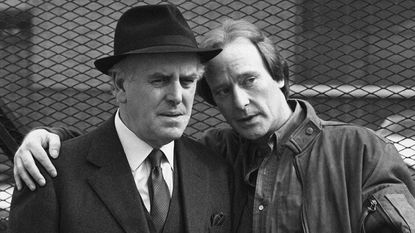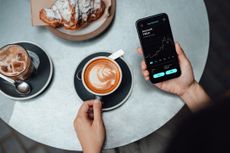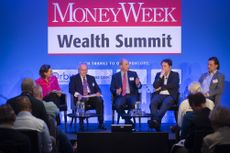The days when you could get 7% from your bank are long gone – so what do you do?
With interest rates at rock bottom for so long, we’ve been forced to move from saving to speculating to earn any sort of return. Dominic Frisby asks where we should put our money now, and explains where he’s put his.


Earlier in the week I stumbled across an old TV ad from the 1980s for the Leeds Permanent Building Society. It featured George Cole (he of Arthur Daley fame) bumbling from wide-boy investment opportunity to wide-boy investment opportunity.
The moral of the ad was that, instead of getting involved in harebrained businesses, you’re better off putting your money in the Leeds Liquid Gold account, because it pays 7.65% interest. 7.65%! This was a normal rate of interest back then.
We’ve been forced into becoming a nation – nay, a world – of speculators
The Leeds Permanent Building Society was not so permanent as it turned out. It merged with the Halifax Building Society, and lost its name. The Halifax then merged with Bank of Scotland to form HBOS in 2001. Then, following the global financial crisis, that became part of the Lloyds Banking Group.
Subscribe to MoneyWeek
Subscribe to MoneyWeek today and get your first six magazine issues absolutely FREE

Sign up to Money Morning
Don't miss the latest investment and personal finances news, market analysis, plus money-saving tips with our free twice-daily newsletter
Don't miss the latest investment and personal finances news, market analysis, plus money-saving tips with our free twice-daily newsletter
Today the equivalent Halifax Everyday Saver account pays 0.01%. We don’t have the option of 7.65% interest at the Leeds or anywhere else, and so we get involved in harebrained businesses, otherwise known as the stockmarket, instead.
This dynamic explains so much. When you do a job, you expend energy. For expending that energy, you are paid. The money you are paid is, in a way, a store of that energy, which you can then draw on at some later stage to buy some kind of good or service. For the system to work, it is vital that monetary energy is retained.
When interest rates roughly reflected inflation, as in the 1980s, most of your energy was retained. There was an honesty to the system – that has long since disappeared.
As globalisation took hold in the 1990s, the incredible manufacturing powerhouse that was China was able to export its cheap goods aplenty and we bought them aplenty. China’s manufacturing costs were a lot cheaper than ours, and so China effectively exported lower prices. Meanwhile, in the West, in our measures of inflation we focus on consumer prices, which, thanks to China, kept getting lower and lower. “Look, inflation is low”, said central bankers, as they ignored all the debt being created to buy houses, commercial property and financial assets. And so interest rates gradually got lower.
Some could see that their money was losing its energy. House prices were going up at ridiculous rates. It was easy to borrow money. And so buy-to-let became a thing. You’re better off keeping your money in “bricks’n’mortar”. Don’t sell your flat as you move up the ladder to buy a house, just keep the flat and borrow more.
Instead of putting your money into the Leeds, you might have bought government bonds or gilts. These also paid you an interest rate that compensated you for the loss in purchasing power of your currency, and helped retain that energy you had expended earning the money in the first place. But since 2008, that option no longer exists either. There is no way you’ll hang on to your expended energy. Pension funds only buy bonds because they have to. I’m not joking – regulations oblige them.
We had the transformative invention of tracker funds and the exchange-traded fund (ETF). No longer did you have to take individual company risk, or individual fund manager risk; you could just buy the stockmarket.
So where do you put your money now?
And so, this century, the stockmarket, especially to our American brothers and sisters, effectively became a savings vehicle that returned you somewhere between 5% and 20% a year. (Most years).
In fact, it became such an effective savings vehicle that many began using leverage (another word for debt) to buy more, and so the money supply increases. It was a bit like buy-to-let. And the stockmarket, especially in the US, continually rises to levels which for years have had fund managers scratching their heads and wondering why they bother. The S&P 500 has become a savings vehicle.
I remember interviewing James Turk, founder of Goldmoney, back in 2006. We talked at great length about the loss of purchasing power of fiat money. James went so far as to write a book: The Coming Collapse of the Dollar and How to Profit from It. “Buy gold,” James would say. At the time it was trading around $500 an ounce.
“If we buy gold,” I asked him, “how do we know when to sell it?” “You’re not going to sell it,” James said. “You’re going to spend it.” In other words we were going to go back to using gold as money.
Like Turk, Satoshi Nakamoto took a look at what was going on with the system, and he didn’t like what he saw either. So he invented a new system of money called bitcoin. It really caught on. Here was a new system of money to save in and, boy, did it retain its energy. “HODL!” (hold your bitcoin indefinitely) has become its war cry.
Today bitcoin is gold 2.0, they say. Digital gold. It is immune to the pernicious forces of inflation. Its inflation rate is set in code. Even large public companies are using it as their savings vehicle. Microstrategies (Nasdaq: MSTR) has just raised another billion dollars to buy bitcoin, on top of the billion and a half it has already spent. Jack Dorsey’s Square announced yesterday that it has purchased another $190m-worth.
So we buy bitcoin, we HODL. How do we know when to sell? You’re not going to sell your bitcoin, they say. You’re going to spend it. I’ve heard that one before.
No, really you are. Bitcoin’s most vocal proponents constantly lobby companies and individuals to start accepting bitcoin. You’ll be able to buy a Tesla with it. Some house vendors now accept bitcoin. You can buy art – in the form of NFTs (more on those in the next issue of MoneyWeek, out on Friday – subscribe here if you don’t already have a subscription).
What about the capital gains tax implications of spending bitcoin (rather than trading it)? Do you have to pay CGT when you spend it? I’m looking forward to watching that argument. Life would be so much easier if governments protected the purchasing power of the currency they issued. But life isn’t easy, and governments print. What’s your chosen savings vehicle?
Daylight Robbery – How Tax Shaped The Past And Will Change The Future is now out in paperback at Amazon and all good bookstores with the audiobook, read by Dominic, on Audible and elsewhere.
Dominic Frisby (“mercurially witty” – the Spectator) is the world’s only financial writer and comedian. He is MoneyWeek’s main commentator on gold, commodities, currencies and cryptocurrencies. He is the author of the books Bitcoin: the Future of Money? and Life After The State. He also co-wrote the documentary Four Horsemen, and presents the chat show, Stuff That Interests Me.
His show 2016 Let’s Talk About Tax was a huge hit at the Edinburgh Festival and Penguin Random House have since commissioned him to write a book on the subject – Daylight Robbery – the past, present and future of tax will be published later this year. His 2018 Edinburgh Festival show, Dominic Frisby's Financial Gameshow, won rave reviews. Dominic was educated at St Paul's School, Manchester University and the Webber-Douglas Academy Of Dramatic Art.
You can follow him on Twitter @dominicfrisby
-
 Barclays warns of significant rise in social media investment scams
Barclays warns of significant rise in social media investment scamsInvestment scam victims are losing an average £14k, with 61% of those falling for one over social media. Here's how to spot one and keep your money safe
By Oojal Dhanjal Published
-
 Over a thousand savings accounts now offer inflation-busting rates – how long will they stick around?
Over a thousand savings accounts now offer inflation-busting rates – how long will they stick around?The rate of UK inflation slowed again in March, boosting the opportunity for savers to earn real returns on cash in the bank. But you will need to act fast to secure the best deals.
By Katie Williams Published
-
 Halifax: House price slump continues as prices slide for the sixth consecutive month
Halifax: House price slump continues as prices slide for the sixth consecutive monthUK house prices fell again in September as buyers returned, but the slowdown was not as fast as anticipated, latest Halifax data shows. Where are house prices falling the most?
By Kalpana Fitzpatrick Published
-
 Rents hit a record high - but is the opportunity for buy-to-let investors still strong?
Rents hit a record high - but is the opportunity for buy-to-let investors still strong?UK rent prices have hit a record high with the average hitting over £1,200 a month says Rightmove. Are there still opportunities in buy-to-let?
By Marc Shoffman Published
-
 Pension savers turn to gold investments
Pension savers turn to gold investmentsInvestors are racing to buy gold to protect their pensions from a stock market correction and high inflation, experts say
By Ruth Emery Published
-
 Where to find the best returns from student accommodation
Where to find the best returns from student accommodationStudent accommodation can be a lucrative investment if you know where to look.
By Marc Shoffman Published
-
 Best investing apps
Best investing appsWe round up the best investing apps. Looking for an easy-to-use app to help you start investing, keep track of your portfolio or make trades on the go?
By Ruth Emery Last updated
-
 The world’s best bargain stocks
The world’s best bargain stocksSearching for bargain stocks with Alec Cutler of the Orbis Global Balanced Fund, who tells Andrew Van Sickle which sectors are being overlooked.
By Andrew Van Sickle Published
-
 Revealed: the cheapest cities to own a home in Britain
Revealed: the cheapest cities to own a home in BritainNew research reveals the cheapest cities to own a home, taking account of mortgage payments, utility bills and council tax
By Ruth Emery Published
-
 UK recession: How to protect your portfolio
UK recession: How to protect your portfolioAs the UK recession is confirmed, we look at ways to protect your wealth.
By Henry Sandercock Last updated